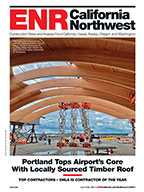Thousands of people will celebrate the May 9 grand opening of the exterior renovation of Denver Union Station into a sprawling $500-million multimodal transportation hub for the Mountain West.
Union Station’s transit component includes an underground regional bus facility with 22 bays, an eight-track commuter rail hall with five platforms covered by a sweeping canopy and significant landscaping and improvements to surrounding streets.
The Union Station design-build project stretches over 40 acres in downtown Denver’s Central Platte Valley and was done under the aegis of the Denver Union Station Project Authority (DUSPA) as owner. The redevelopment is part of metro Denver’s multibillion-dollar FasTracks transit project, one of the largest, most complex transportation developments in the United States. FasTracks consists of expanding bus routes and rail lines.
Contractors are pursuing LEED-Silver certification for the Union Station project.
“The Union Station redevelopment was complicated, with multiple funding sources, complex design challenges and a lot of properties and property owners. But everybody played well in the sandbox,” said Bill Mosher, senior managing director for the Trammell Crow Co., Denver, the owner’s representative for the Union Station project. Funding sources included two federal loans, federal and state grants and proceeds from land sales.
“I don’t think people realize yet what this intermodal hub means for the city and the state,” said Mark Imhoff, director of the Colorado Dept. of Transportation’s Division of Transit and Rail, and a DUSPA board member. “Bringing all those transportation modes together in a real vibrant place is really cool. It makes us feel like a real city.”
Construction started in early 2010, and Amtrak moved its operations back to Union Station from a nearby temporary facility this February.
City’s Newest Plaza
“We spent $32 million on public improvements—brick finishes, lighting, planters shaped like teardrops that channel the flow of people from trains, granite seating benches and lots of trees,” said Chet Haptonhall, Union Station project manager for Kiewit Corp., the transit component’s general contractor.
“We upgraded materials when we could, going from concrete pavers to granite in some cases,” Mosher said. “That’s where the recession helped us. We got good bang for our buck.”
Omaha-based Kiewit’s Kiewit Infrastructure Co. led the design-build team for the transit component, working with other company subsidiaries Kiewit Building Group and Mass. Electric Construction Co.
Kiewit had some 200 workers on the transit project at peak. Kiewit Building Group built the five-story, 110,000-sq-ft One Union Station office building on the station’s south side, anchored by the new headquarters of the Denver-based Antero Resources energy company.
Kiewit also teamed up with architects Skidmore, Owings & Merrill LLP (SOM), which drafted the master plan and then became project architect and engineer; transportation construction specialist AECOM Technology Corp.; and landscape architect Hargreaves Associates.
Other work on the underground bus facility, according to Kiewit, included interior finishes such as placing yellow glass wall tiles under the skylights; laying terrazzo stone floors; finishing elevators and escalators; and installing cabling in the communications/data room. Panels of large display monitors were installed near entrances to provide scheduling and messaging information.









Post a comment to this article
Report Abusive Comment